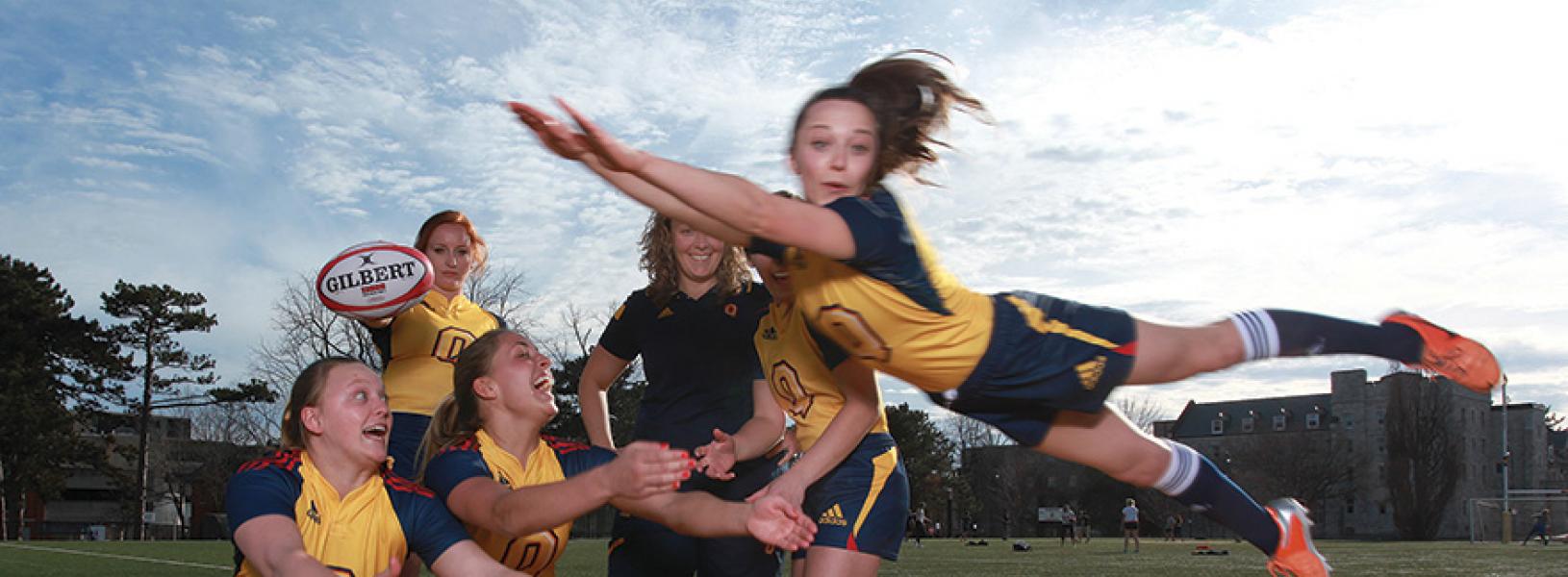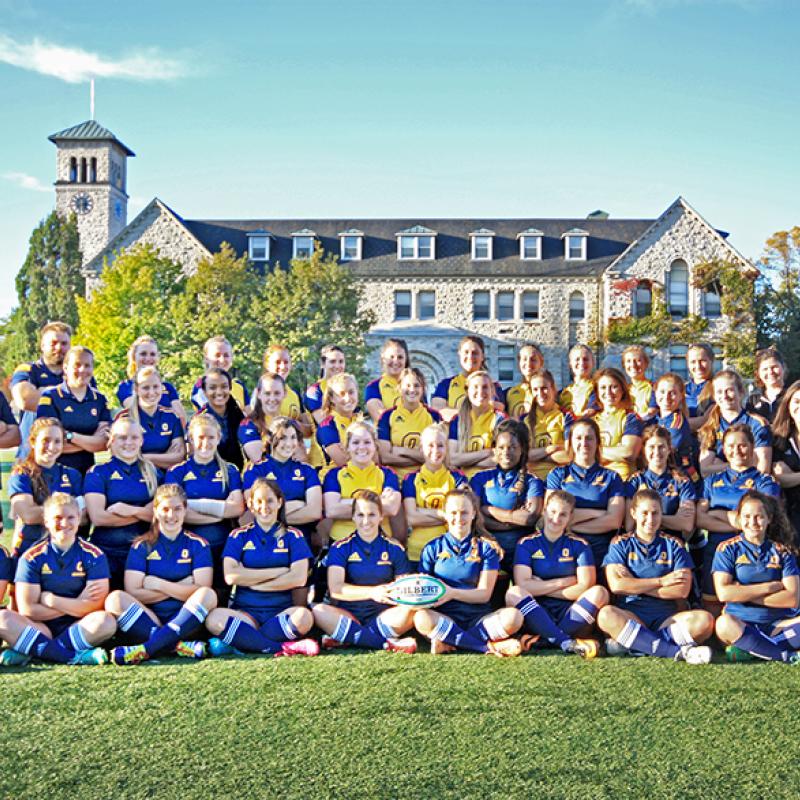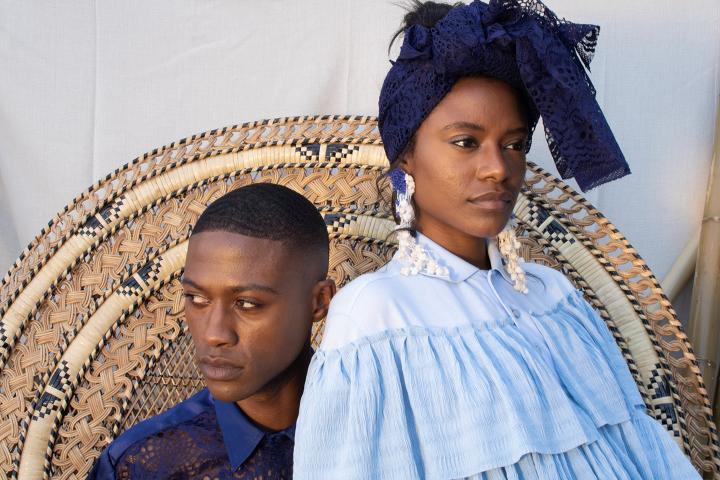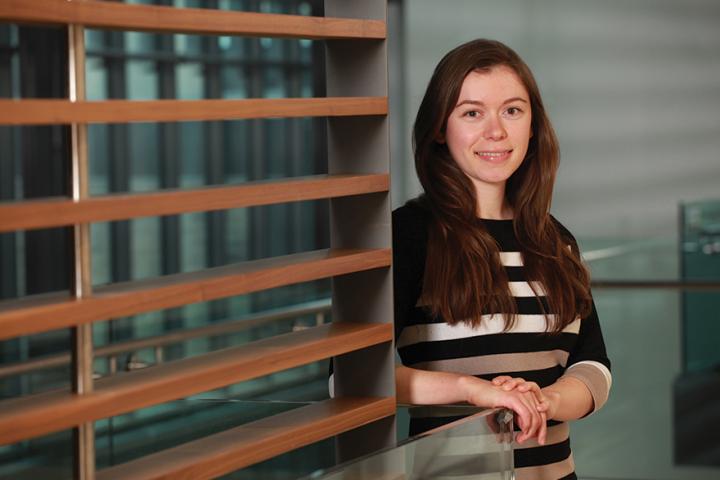Right now, the women are playing with their local rugby clubs. Or they’re at the gym, working through strength conditioning regimes. The team’s leadership group (from whom this year’s captains will be chosen) are checking in with their teammates, ensuring they are getting their training in. The new recruits are starting to think about the late August training camp, when they will get to work with their teammates for the first time.
And at the end of those five games, if all goes well, they’re in the provincial OUA playoffs in October. Then come the national CIS Championships in November. As the host this year, Queen’s automatically gets a spot in the November games, but the players – and their coaches – would rather get to the CIS championships as the OUA champions (as they were just two years ago.)
Head Coach Beth Barz is at home, too, planning out the season. She has had a little more time this month to focus on rugby: her full-time job as a high school teacher wrapped up for the summer in late June. Her assistant coaches, Sean Dunleavy, Vicki Wilson and Blake Wilson, also have other full-time jobs. They all put in long hours, year-round, for the team. But they make it work, for the love of the game, and with help from the staff at Queen’s Athletics & Recreation.
“There’s no way we could do this without them,” says Barz, of the behind-the-scenes staff who provide athletic therapy, order team equipment, keep track of player eligibility, and organize bookings.
Plans A and B
Even with the berth at the CIS championships in November, Barz and her coaches need to keep their focus on that very first game, in September, to integrate the new players and work on the team’s goals. “We need to plan for the whole season, all the way through the first week of November,” she says. “There’s a plan A, to go all the way through [the OUA playoffs] and a plan B. We wouldn’t be doing our jobs as coaches if we didn’t think through plan B.”
Her players agree.
“The most valuable thing I’ve learned from playing on a varsity team is to focus on the present,” says Hannah Bradshaw, who has played the wing position for the Gaels for three seasons. “It’s important to set goals, but it is the preparation that counts. We try to focus one practice at a time and then one game at time. The idea of playoffs is only in the back of our minds.”
The season begins
Once back on campus, the players will get right into their fall routine. Practice is four days a week, two hours a day, balanced with classes and assignments.
On game days, they work for six or seven hours. After every game comes a post-mortem, watching video of the game, and breaking down all their tactics. Barz and her colleagues will ask the athletes, “What do you see here? What decision did you make there? What other options did you have?” From this discussion, coaches and athletes will set their goals as a team, for the next week, as well as for the rest of the season.
“The athletes are very much part of the decision-making process. It’s not top-down. It’s something we do all together,” says Barz.
Athlete-centered approach
It’s a much different approach than she experienced when she was a rugby player, first in high school and then at Queen’s.
“I started coaching as I was coached, which was very much drill-oriented. In the last six or seven years, we have gone to an athlete-centred approach, which uses teaching games for understanding. This gives athletes the opportunity first to play and then to think about how it went. They’re not standing in a line doing the same thing over and over. We still do drills on occasion, but it’s all within the context of the game that we’ve created, with the outcome goals that we want to work on.”
The art of coaching
“When I was in high school I took a couple of coaching courses,” says Barz. “I didn’t see a lot of other women out there coaching rugby, but I thought that more women should be coaching women. I knew I had a lot to learn and proceeded to learn as much as I could. I’m still learning.”
It helped that she had versatility as a player; she had played both scrum half and prop, two very different positions. So she had a well-rounded understanding of the game from a player’s point of view.
She also pursued additional certification: she has an advanced diploma through the National Coaching Certification Program. She regularly teaches NCCP programs in rugby and fundamental movement skills.
But it’s not just her players who benefit from her skills and training as a coach. She now teaches the art of coaching to people in other sports, through a program of the Canadian Sport Institute.
“When you’re coaching at a high level, your own sport can be a bit insular,” says Barz. “It’s nice to be able to bounce ideas off someone in a different sport.”
In 2006, Barz was named CIS Coach of the Year. In 2013-14, the year Queen’s Women’s Rugby won the OUA championship, she was named OUA Fox40 Female Coach of the Year.
Finding the right people
Coach Barz knows she’s got the right recruits for this year’s team. This is her 11th season as head coach of Queen’s Women’s Rugby. She and Assistant Coach Dunleavy have put a lot of work into ensuring that becoming a Gael is right, for both the student-athlete and the team.
“Our strategy is to connect with the best athletes, and then we want to make sure that those best athletes are also really fantastic people,” says Barz. “One of the early conversations we have is, of course, ‘Do they have the marks to get into Queen’s?’ But I don’t even want to look at marks until I’ve had the chance to actually talk to the athletes and see if they are going to be able to come into this environment and thrive. Do they already have some of the life-skills that we need them to have before they get here? Can they advocate for themselves?
“At Queen’s, it’s not just about being a great athlete with the marks to get in here: we’re bringing you in here to be an integral part of the team. Sometimes, you meet a student and you know, and she knows, that this is absolutely the right team for her. Some of them are not quite sure. They’re thinking about somewhere else, maybe it’s an academic program at another school. The last thing I want to do is have someone come here and then realize that she made a mistake. If the team and the academic program are not in her best interests, I don’t want her here. We have a great relationship with coaching staff at other universities. I have no problem calling someone and saying ‘Hey, have you looked at this athlete?’ or suggesting another program to a student.”
On embracing change
Coach Barz is looking forward to seeing, not only what her new players can bring to the mix this season, but what the other teams do.
“Good coaches change their playing style according to the athletes they have,” she says, “rather than forcing a playing style on them. We have some really good coaches in the OUA, so we’ll see some changes this season. And it’s awesome to coach against teams who have changed their style, and have been able to change, because it forces us to make adaptations. If we don’t change and adapt ourselves, we shouldn’t win. If we do, then we should.”
Welcome to the family
Seasoned veteran Lauren McEwen, who is back for her fifth year of rugby, has some words of welcome for her newest teammates.
“You're at Queen’s now and you've joined our family, so be brave and be fierce, and know that no matter what, we will always have your back.”
The Gaels play their season opener against McMaster on Nixon Field on Sept. 13.
"Rugby is family"
Women’s rugby first came to Queen’s in 1991, thanks to Barb (Relton) Di Nardo, Artsci’91, Ed’93. Di Nardo started playing recreationally in the summer after her second year. In third year, she went on exchange to France, where the sport was very popular. Upon returning to Kingston, she declared that Queen’s needed a women’s rugby team. So she started one.
Di Nardo put a call out for players and remembers being overwhelmed by the response. “About 150 girls showed up!” That first year was one of trial and error. She didn’t have a lot of coaching experience, and there weren’t many formal resources available to her. The first year, her burgeoning team didn’t have practice space on campus, so they played in Kingston’s City Park. With coaching support from Kathie Thompson, Artsci’94, and players from the men’s team, Di Nardo recalls simply “learning by doing.”
While Di Nardo’s tenure as coach lasted for just two years while she finished her ConEd degree, women’s rugby took hold at Queen’s (as it did across Canada, becoming a CIS sport in 1998.) After graduating from Queen’s, Di Nardo also grew her rugby network. These days, she coaches a “minis” program in the Toronto area, with kids aged 4 to 14. “Rugby is family, to me,” says Barb. “It is camaraderie. The social aspect of the game is very important to me. I have fostered that in both the girls’ and boys’ teams I coach.” Rugby is truly a family sport in her household: Di Nardo’s husband, Bill, is also a coach, and all four of their children play. In fact, their daughter Jordi will play rugby for Queen’s, when she starts her first year in September.



